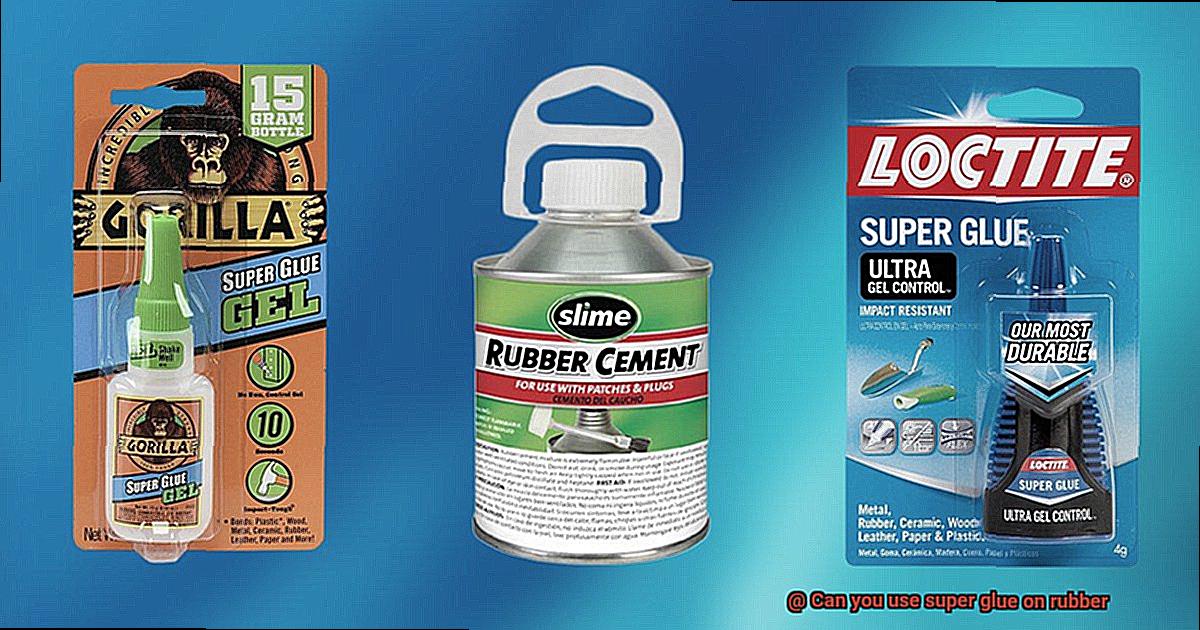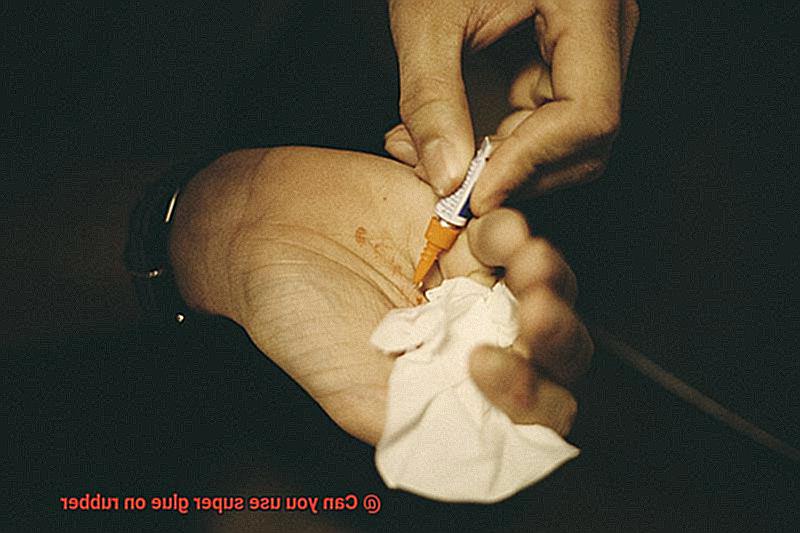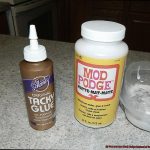Picture this: a world where a single drop of super glue holds the power to mend, seal, and bond just about anything together. It’s like having your very own bottle of magic. But here’s the burning question: can this versatile adhesive conquer the resilient texture of rubber? Or is it simply a recipe for a sticky disaster?
Today, we’re diving deep into the incredible possibilities of using super glue on rubber, ready to unleash a wealth of knowledge that’ll put your mind at ease. Whether you’ve got a torn rubber sole, a leaky hose, or even a beloved rubber toy in need of some TLC, get ready to discover the secret behind creating unbreakable bonds.
Buckle up as we unveil the truth about the remarkable compatibility between super glue and rubber.

What is Super Glue?
Contents
- 1 What is Super Glue?
- 2 Types of Rubber and Super Glue Compatibility
- 2.1 Understanding Rubber: The Dynamic World of Rubber Revealed
- 2.2 Compatibility with Super Glue: The Dance Between Rubber and Adhesive
- 2.3 Factors Affecting Bonding: Unveiling the Intricacies
- 2.4 Surface Preparation: The Foundation of Adhesion Mastery
- 2.5 Testing Compatibility: A Prelude to Bonding Bliss
- 2.6 Alternatives for Incompatible Rubber: When Compatibility Falters
- 3 Preparing the Surfaces for Bonding
- 4 Different Types of Rubber Adhesives
- 5 Applying Super Glue to Rubber
- 6 Other Adhesive Options for Bonding Rubber
- 6.1 Cyanoacrylate Adhesive (CA Glue): Rapid curing time: Known as “CA glue” or “super glue,” cyanoacrylate adhesive sets quickly, forming a strong bond between rubber surfaces within seconds. Superior bond strength: CA glue provides a durable bond capable of withstanding moderate stress and strain. Application method: Apply a thin layer of CA glue to both rubber surfaces, firmly press them together, and hold until the adhesive sets. Epoxy Adhesive:
- 6.2 Rubber Cement:
- 6.3 Contact Cement:
- 6.4 Silicone Adhesives:
- 7 Factors that Affect the Bonding Strength of Super Glue on Rubber
- 8 Conclusion
Have you ever marveled at the power of a tiny bottle of super glue, wondering how it can bond almost anything together with such strength and speed? Prepare to be amazed as we delve into the captivating world of super glue and uncover its secrets.
Super glue, scientifically known as cyanoacrylate adhesive, emerged onto the scene in the 1940s thanks to the ingenious mind of Dr. Harry Coover. Originally developed for military purposes, this remarkable adhesive quickly found its way into various industries and everyday use. Available in liquid, gel, or spray forms, super glue caters to a wide range of needs.
The star ingredient that grants super glue its incredible bonding abilities is cyanoacrylate. This powerful and durable adhesive starts as a clear, colorless liquid and solidifies when it reacts with moisture in the air or on the surfaces being bonded. It’s this lightning-fast drying process that makes super glue ideal for situations where time is of the essence.
One of the most awe-inspiring features of super glue is its exceptional tensile strength, enabling it to withstand pulling forces without breaking easily. Not only that, but it also boasts resistance to water, heat, and many chemicals, making it an invaluable asset in diverse environments and conditions.
But how does super glue actually work its magic? When applied, it initiates a chemical reaction with the moisture present on the surfaces being bonded. This reaction causes the cyanoacrylate molecules to link together, forming an unbreakable bond. This extraordinary bonding capability has made super glue indispensable across numerous industries, including automotive, electronics, medical, and crafts.
When it comes to bonding rubber materials with super glue, there are some key considerations. Natural rubber can present challenges due to its high elasticity and low surface energy. However, synthetic rubbers like neoprene or nitrile may bond more effectively with super glue.
To ensure a successful bond, proper surface preparation is crucial. Removing any dirt, oil, or contaminants from the rubber surfaces using rubbing alcohol or mild detergent will significantly enhance adhesion. Additionally, specialized super glues formulated specifically for rubber may offer enhanced bonding capabilities.

In conclusion, super glue is an extraordinary adhesive that forms robust and enduring bonds between various materials. Its rapid drying time and exceptional tensile strength render it an invaluable solution across countless industries and everyday applications. While bonding rubber with super glue can pose challenges, with proper surface preparation and the use of specialized rubber adhesives, its effectiveness can be maximized.
Types of Rubber and Super Glue Compatibility
Rubber, a marvel of versatility found in everyday items like tires and gaskets, beckons us to explore its compatibility with super glue. In this article, we embark on a journey to understand how different types of rubber interact with super glue. By delving into their unique properties, we equip ourselves with the knowledge needed to make informed choices when bonding rubber materials.
Understanding Rubber: The Dynamic World of Rubber Revealed
Rubber takes on many forms, from natural rubber tapped from trees to synthetic varieties like neoprene and silicone. Each type possesses distinct properties and characteristics that influence its compatibility with super glue. A deep understanding of these nuances is key to successful bonding.
Compatibility with Super Glue: The Dance Between Rubber and Adhesive
Not all super glues are created equal when it comes to rubber compatibility. Natural rubber and synthetic rubbers like neoprene typically form strong bonds with cyanoacrylate-based super glues. However, silicone rubber poses a unique challenge due to its low surface energy, necessitating specialized adhesives for optimal results.
Factors Affecting Bonding: Unveiling the Intricacies
Within a specific type of rubber, compatibility with super glue can vary due to factors such as additives, fillers, and surface treatments. These nuances must be taken into account before applying super glue to ensure a seamless bond that withstands the test of time.
Surface Preparation: The Foundation of Adhesion Mastery
Proper surface preparation lays the groundwork for a robust bond between rubber and super glue. Thoroughly cleansing the surface by banishing dirt, dust, and oils fosters optimal adhesion. The magic lies in employing rubbing alcohol or mild detergents to eradicate impurities that might hinder the bond.
Testing Compatibility: A Prelude to Bonding Bliss
Before committing to a large application, it is wise to conduct a small compatibility test on an inconspicuous area. This preliminary examination allows us to gauge the strength of the bond and ensure compatibility between the rubber and super glue, providing peace of mind for future applications.
Alternatives for Incompatible Rubber: When Compatibility Falters
In cases where super glue fails to provide the desired bonding strength for rubber materials, alternative options like specialized rubber adhesives, epoxy adhesives, or contact adhesives can be considered. These alternatives offer a lifeline when compatibility becomes elusive.
Preparing the Surfaces for Bonding
Unlock the secret to achieving flawless bonding results by mastering the art of surface preparation. In this article, we will delve into the crucial steps required to prepare rubber surfaces for bonding with super glue. Get ready to explore a world of cleanliness, roughening up, debris removal, partner consideration, and patch testing. With these expert tips, you will become a master of bonding surfaces.
Cleanliness is Key:
Before embarking on your bonding journey, ensure that both the rubber surface and the target surface are squeaky clean. Dirt, dust, or oils can create a barrier between the adhesive and rubber, resulting in a weak bond. Use a clean cloth and mild detergent for a wipe-down. But remember, avoid harsh chemicals that could harm your materials.
Roughening Up:
Super glue struggles to grip smooth and non-porous rubber surfaces. Conquer this challenge with a little roughening up. Gently score or sand the rubber surface using sandpaper or a utility knife. This creates tiny grooves, maximizing surface area for the adhesive to hold onto, resulting in an incredibly strong bond.
Say Goodbye to Debris:
After roughening up the rubber surface, eliminate any pesky debris or particles that may have been generated. Compressed air or a brush will ensure no loose particles remain. These particles can interfere with the bonding process and weaken your bond – we can’t have that.
Consider the Partner:
Remember, bonding takes two. While preparing the rubber surface is vital, it’s equally important to consider the characteristics of the target surface. Whether it’s metal, another rubber surface, or something else entirely, cleanliness is key. Ensure it’s free from corrosion or rust and primed if necessary. A strong bond requires both surfaces to be in top shape.
The Patch Test:
Before going all-in with super glue, perform a patch test. Apply a small amount of adhesive to an inconspicuous area of the rubber and check for compatibility and potential damage. This is particularly crucial if you’re working with a specific type of rubber that may have unique properties or coatings.
Different Types of Rubber Adhesives
In the world of adhesive bonding, rubber adhesives stand out for their versatility and unique properties. From contact adhesives to specialized formulations, there is a range of options available for various applications. In this comprehensive guide, we will explore the different types of rubber adhesives, their specific uses, and essential considerations when choosing the right adhesive for your project.
Contact Adhesive: The Ultimate All-Rounder
When it comes to versatility, contact adhesive takes center stage. Whether you’re in the automotive, construction, or footwear industry, this adhesive is a reliable choice. Available in both solvent-based and water-based forms, contact adhesives create a strong bond upon contact. Perfect for bonding shoe soles, gaskets, and seals, it offers flexibility and durability.
Cyanoacrylate Adhesive: The Magic Bonding Solution
Looking for an adhesive that works like magic? Enter cyanoacrylate adhesive, also known as super glue. While not specifically designed for rubber bonding, it can still prove effective on rigid rubbers. However, be cautious; not all super glues are suitable for rubber applications. Always check the label or manufacturer’s instructions before diving into your rubber project.
Epoxy Adhesive: Strength and Durability Combined
When strength and durability are paramount, epoxy adhesives come to the rescue. These versatile adhesives can bond a wide range of materials, including rubber. Consisting of two parts – a resin and a hardener – epoxy adhesives require mixing before use. Once applied, they create an unbreakable bond that can withstand even the harshest environments.
Silicone Adhesive: Heat Resistance at its Finest
For applications requiring high-temperature resistance, silicone adhesive is the hero you’ve been waiting for. Specifically formulated for bonding silicone rubber materials, it offers excellent flexibility and electrical insulation properties. Whether you’re in the electronics or automotive industry, silicone adhesive has got your back.
Polyurethane Adhesive: Tough as Nails
When it comes to strength and durability, polyurethane adhesive takes center stage. This adhesive can bond a wide range of materials, including rubber, with excellent resistance to water, chemicals, and heat. From automotive to construction and marine industries, polyurethane adhesive ensures your bonds are strong and long-lasting.
Applying Super Glue to Rubber
Super glue, also known as cyanoacrylate adhesive, is a versatile adhesive that is commonly used for bonding various materials together. However, when it comes to rubber, there are certain considerations and techniques that need to be followed for successful bonding.
The first step in applying super glue to rubber is to ensure that the rubber surface is clean and free from any dirt, dust, or grease. This can be achieved by wiping the surface with a mild detergent solution or rubbing alcohol and then drying it thoroughly. Cleanliness is essential because any contaminants on the surface can interfere with the bonding process.
After the rubber surface is clean, it is recommended to roughen the surface slightly. This can be done by using sandpaper or an emery cloth to gently roughen the surface. The purpose of this step is to create more bonding area for the glue. However, it is important not to overdo it as excessive roughening may weaken the rubber. Balance is key.
Once the rubber surface is prepared, a small amount of super glue can be applied directly onto the surface. It is important to use a thin layer of glue rather than applying it in large quantities. Excess glue may squeeze out and create a messy appearance. Remember, less is more in this case.
After applying the glue, it is necessary to press the rubber pieces together firmly to ensure proper adhesion. Holding them in place for a few minutes until the glue sets is recommended. For larger or heavier objects, clamping or using weights may be necessary to provide additional support during the bonding process. This will help create a strong bond between the rubber pieces.
It is important to note that super glue bonds quickly, so it is essential to work efficiently and accurately. Once the glue dries, it forms a strong bond that is resistant to moisture, temperature fluctuations, and some chemicals. However, it may not be suitable for all types of rubber, especially those with high flexibility or softness. If you are unsure about whether super glue is suitable for your specific rubber material, it is always recommended to test a small area first before applying it to the entire surface.
Other Adhesive Options for Bonding Rubber

Rubber materials are widely used in various industries and products, making the need for effective adhesive options crucial. While super glue is a popular choice, there are other adhesives available that offer unique properties and advantages. In this blog post, we will delve into alternative adhesive options for bonding rubber materials, including cyanoacrylate adhesive, epoxy adhesive, rubber cement, contact cement, and silicone adhesives.






